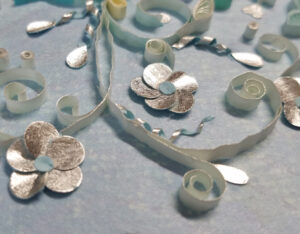Quilling a technique that involves rolling strips of paper into small coils, and shaping the coils into decorative forms and groupings. The designs so formed look much like metal filigree, and indeed, another name for quilling is “paper filigree”. It was most popular in the 18th and 19th centuries, and was considered suitable work for elegant young ladies. It is even mentioned in Jane Austen’s Sense and Sensibility. Early uses of quilling included ornamenting tea caddies, candle sconces, and deep-set floral designs made entirely of tightly coiled papers. Quillers today can buy pre-cut strips of paper in many colors, ranging from 1/16th” to 1″ wide. I usually work with 1/8th” wide paper. The paper is about 60-70 lb weight, but now it is also available in card stock. It is rolled around a pin, tapestry needle, toothpick, or other tool of preference, or one can purchase a “quilling tool”, which is like a slotted needle with a handle. “White” glue is applied sparingly and strategically. Here is a picture straight on, and a side view to show the dimensional nature of quilling.


Giclee – is the technique of taking a digital image and printing it on a large format, high resolution computer printer. “Giclee” is named from the French word meaning “that which is sprayed”, referring to the fact that ink jet printers spray ink onto paper. If printed on archival paper, a giclee will be a high quality, permanent print.
Gilding – the application of metal leaf, usually some type of gold, to a surface. In my work, I generally use the technique of “oil gilding” to adhere 23k gold leaf to paper. This leaf comes in sheets of 3” x 3”, and it is so thin as to be translucent. Genuine gold never tarnishes, so it does not require any varnish or finishing coat, unless it is to be handled frequently. I occasionally work with aluminum, silver and copper leaves as well. The pictures above show 6K gold leaf on the petals, which gives them a silver tone.
Lithograph – a method of reproducing artwork in which the image is separated into different color components (4-color is standard, that is, the technique takes an image and separates it into cyan, magenta, yellow, and black (CMYK).) Those are then engraved on rollers, and the press is run. If printed on archival paper, lithography will yield high quality, permanent prints.
